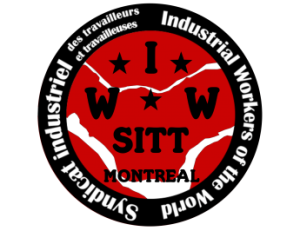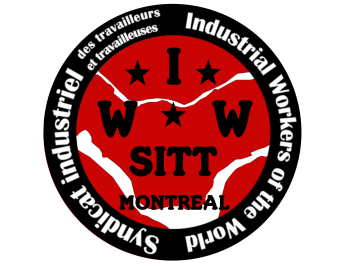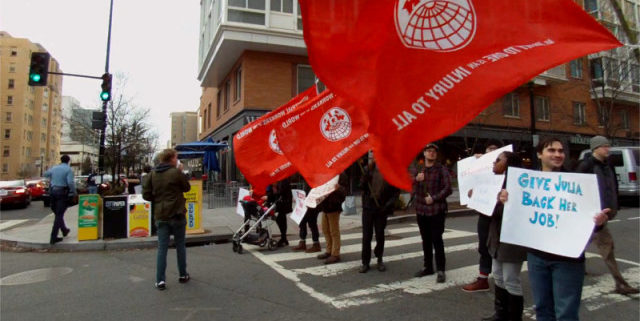Let's find other solutions than the strike!
Rasmus Hästbacka and Kristian Falk, of the Swedish trade union SAC (Swedish Workers' Central Organization, or Central Organization of Workers of Sweden), argue for a third way between the “consensual fundamentalism” of Sweden’s dominant union bureaucracy and the “idealization” of rank-and-file strikes: we need to relearn how to put pressure on our workplaces.

What defines a trade union movement?? It is a movement made up of colleagues who stick together and act together. It must be distinguished from the union bureaucracy represented by elected officials and union officials perched far from the base and paid separately from the workers.. In the Swedish labor market, the trade union movement takes the form of small scattered islands in the shadow of the big trade union bureaucracies. These islets include the Syndicalist SAC, the Swedish Longshoremen's Union and some local labor branches within the LO central bureaucracies (Landsorganisationen i Sverige or Swedish National Organization), TCO (Central Organization of Salaried Employees or Confederation of Professional Employees) and SACO (Central Organization of Swedish Academics or Swedish Confederation of Professional Associations).
Revival of the Swedish trade union movement is hampered by “consensual fundamentalism”: senior union officials focus on building consensus (consensus) with employers through collective agreements but for decades, employers are increasingly neglecting the interests of workers in favor of the search for this consensus. The labor market is deteriorating in Sweden, and working conditions begin to resemble those of the beginning of the 20e century: there are dangerous working environments, very low wages and simply criminal employers.
As unionists, we do not reject legally binding collective agreements. In fact, at SAC, we are currently testing a new collective bargaining strategy. But we always emphasize that it is the collective struggle that gives collective agreements their value..
Romance strikes
While senior LO officials, of TCO and CESO suffer from consensual fundamentalism, the grassroots opposition often suffers from an obsession with the strike. Within the popular labor movement in Sweden, we often hear a call for big strikes, even a general strike. The use of strikes has grown in response to the questioning of the Swedish employment protection law, the proliferation of low wages and attacks on the right to strike. In 2019, groups attempted to organize a symbolic strike to highlight the climate crisis, but to our knowledge, no workplaces have been closed.
We must recognize that we ourselves, CAS members, sometimes let this obsession with the strike win us over. U.S. too, we tried to rush a few. The strike in defense of the unemployment insurance funds in 2006, which were attacked by the Swedish government, is an example. It ended in a painful defeat.
The frequency of strikes in Sweden has actually been very low since the early 1990s. 1990 and the call to strike tends to be a fantasy. The organizers of these so-called strikes idealize the French strikes, or those of Sweden before the Second World War. But the all-out strike should not be fetishized, and it has no value if it does not lead to results. This vision of the struggle is part of the fallacious myth that the strike is still the employees' best weapon..
An important fact, but little known, is that the unionist SAC has historically been skeptical of strikes. This was expressed from 1910 in the Manifesto to the Workers of Sweden, published by the SAC. Workers' struggles must not be reduced to an "arms crossed" struggle, it says in the Manifesto, and "that time is over, where it was enough to throw the shovel and the plane aside and impose our conditions on the employers.. According to trade unionists, strikes are often costly, long and can easily be ruined by scabs and lock-out. Swedish employers have often responded with lock-out of solidarity in many industries.
The objective of lock-out was not only to win the ongoing struggle. Political scientist Peter A.. Swenson talks about a longer term goal:
The lockouts enabled the ruling class to mold the unions into partners in the regularization of the labor market. The union leadership, which is closely linked to the Social Democratic Party, did not oppose the movement desired by the employers. What stood in their way, it was the lack of control over decentralized militancy in the ranks. Therefore, […] trade unionists sometimes welcomed lockouts or threats of lockouts. The employers' whiplash gave them an ideologically consistent pretext to intervene against disruptive grassroots activism.
During the golden age of strikes, in the years 1920, Swedish trade unionists have become even more skeptical of “all-out” strikes. Unionists have focused the struggle internally on union employment services (employment offices) and on increasing the influence of workers on the way workplaces are run. The internal struggle could take the form, for example, collective slowdowns. Union employment services could also stipulate that employers must follow the order and conditions dictated by unions when hiring workers.. When these services were effective, they allowed workers and the unemployed to pursue common claims against the employer party.
Increase the pressure
In SAC education programs, we have learned to emphasize that the road to successful strikes is usually a long one. Workers can simply start by speaking up, for example by asking to have their say on the schedules. Ensuite, they can have a petition signed to ask that the employer pay for their work uniforms. If the workload is high, the next step may be to ask for more people to be hired. If management is unresponsive, maybe it's time to start refusing overtime.
It takes time to develop the ability to lobby employers. We end up forgetting it by focusing all our attention on implementing epic strikes. Our colleagues must learn to win small battles before seeing if they are ready to take the next step.
We present below a series of means of pressure that contribute to strengthening the ability to strike. These options impose four different types of pressure: morale, psychological, economic and legal.
1) moral pressure
Exercising moral suasion means that workers appeal to the will of bosses to do what is right according to their own moral compass., or the desire to be seen as fair in the eyes of staff. for example, workers can question decisions made at staff meetings, conduct employee surveys and critique management actions in their local union newspaper.
Moral suasion is humiliating for bosses. of course, but it often happens that the bosses do not care about being perceived as unfair and that they and they do not perceive this pressure as a punishment. In such cases, moral suasion will have no effect, but psychological pressure might do the trick.
2) psychological pressure
Psychological pressure is shamelessly putting bosses in hot water. The goal is to disturb them. for example, unionized workers could send warnings to bosses who treated their co-workers badly. According to Swedish labor law, only employers can take disciplinary action, but that does not prevent the union from issuing written warnings to bosses and informing all employees..
Another example is to sow discord between bosses.. Employees can try to ally themselves with bosses who are receptive to worker demands and oppose bad bosses together. Workers can also visit senior managers to persuade them to put pressure on their subordinates.
Another variant of psychological pressure is to distance oneself from management. The bosses are then made to understand that the workers do not want to have anything to do with them until they come up with sensible solutions.. They and they could, for example, boycott the company party, organize Christmas dinners without the bosses or give up a business trip.
3) Economic pressure
Workers can certainly exert economic pressure on their employer by lowering their income or increasing their expenses., but they can also do it by playing the leadership game. How can this be done ?
One method is to scrupulously follow all the rules. This is called a “work to rule”, because it allows workers to remain in their workplace while significantly extending the time required to complete all tasks.
We can also think of “union subcontracting”. This means that pressure is put on an employer through another employer who has some connection with the first one.. for example, if a labor dispute arises in a cleaning company that works with other companies, the management of the cleaning company may be put under pressure by a union notice sent to client companies.
The best-known forms of economic pressure are strikes and blockades. Strikes generally cause a complete stoppage of work, while blockages lead to the interruption of certain parts of the work process. In Swedish labor law, blocking is also called “partial industrial action”.
Blockages come in many forms: refusal to work overtime, refusal to perform certain tasks, refusal to use certain work tools, refusal to participate in business trips, blocking the transfer of the labor force between different workplaces within the same company, refusal to deliver goods to certain companies, blocking the hiring of new and new employees (new employment blocked), etc.
Blocking the hiring of new people is a call for solidarity from job seekers: they are asked not to accept employment in the workplace until the conflict is resolved. Swedish law stipulates that job seekers then have the right to neutrality, which means that the public employment service must not refer jobseekers to this workplace.
Another method, called "good strike" or "good blocking", originated in the customer service industry. It consists of offering consumers a cheaper or better quality service at the expense of the employer.. It can be done, for example, by having employees only perform tasks that directly affect customers and ignore other tasks.
The struggle through the unions affects the means of production. It can be combined with actions on the part of consumers., whether the people who own the means of production call for such actions. Boycotting is a well-known method, but its opposite is less so. Unions can offer certification to employers who meet certain requirements and recommend the public to buy from them: this is what we could call a “union label”.
4) legal pressure
legal pressure, as for her, relevant when employers violate laws and agreements. According to Swedish labor law, legal remedies are mainly exercised by individuals and it is up to the union to initiate a process of collective bargaining under the codetermination law (The Co-determination Act). However, it is better for staff to keep things under control in the workplace and combine legal pressure with other types of pressure.
Reviving the labor movement
A strike is the result of a long process. Over this one, workers may find that other actions work better than striking in their workplace. Ultimately, it's the results that count: the goal is to create a better society and a more ethical professional world.
Within the SAC, union officials have a duty to help locals who decide to strike, even if they are skeptical of the strike. Locals are also well advised to think carefully about the chances of winning a strike before undertaking one.
The organization of work is not always a long calm river, but humor generally strengthens the fighting spirit. In his memoirs, Swedish trade unionist John Andersson tells the story of a wage dispute at the port of Gothenburg in 1912.
In response to longshoremen who had slowed down, foremen had been sent to the holds to compensate for losses. The workers then responded by working even more slowly and singing the Christian hymn. The prince of darkness descends ("the devil descends"). and, when the exhausted foremen started to climb the ladder to get out, the workers sang Your clear sun rises again ("Your glorious sun rises again in the sky").
Rasmus Hästbacka is a lawyer and member of the Umeå local branch of the SAC. Kristian Falk is an economic historian and member of the Enköping-Heby section of the SAC. Another version of this article was posted in Swedish.
Original text by Rasmus Hästbacka and Kristian Falk for Organizing Work
Translation: Alex V. et Florence M. for SITT-IWW Montreal.





Leave a Reply
Want to join the discussion?Feel free to contribute!